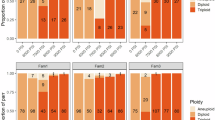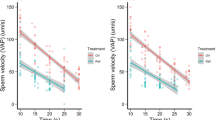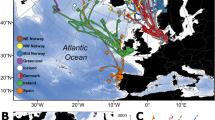Abstract
Atlantic salmon precocious parr are dwarf mature males able to mate with adult females making profit of their small size. In this work the reproductive success of the dwarf males in the presence of an adult male and female spawning couple has been estimated in three different situations under simulated natural conditions at the Lapitxuri experimental channel (France). Different hypervariable minisatellite loci were used in the paternity assessment of the progeny. In all the situations tested, precocious parr were able to fertilize between 24.7 and 89.3 per cent of the total eggs. The results are discussed in relation to the important role of Atlantic salmon precocious parr in population structure and the evolution of salmon populations.
Similar content being viewed by others
Article PDF
References
Burke, T. 1989. DNA fingerprinting and other methods for the study of mating success. Trends Ecol Evol, 4, 139–144.
Burke, T, Dolf, G, Jeffreys, A, and Wolff, R. 1991. DNA Fingerprinting: Approaches and Applications. Birkhäuser Verlag, Basel.
Davidson, W S, Birt, T P, and Green, J M. 1989. A review of genetic variability in Atlantic salmon, Salmo salar L., and its importance for stock identification, enhancement programmes and aquaculture. J Fish Biol, 34, 547–560.
Debenham, P G. 1992. Probing identity: the changing face of DNA fingerprinting. TIBTECH, 10, 96–102.
Gill, P, Jeffreys, A J, and Werrett, D J. 1985. Forensic application of DNA “fingerprints”. Nature, 318, 577–579.
Hindar, K, Ryman, N, and Utter, F M. 1991. Genetic effects of aquaculture on natural fish populations. Aquaculture, 98, 259–261.
Hutchings, J A, and Myers, R A. 1988. Mating success of alternative maturation phenotypes in male Atlantic salmon, Salmo salar L. Oecologia, 75, 169–174.
Jeffreys, A J, Wilson, V, and Thein, S L. 1985. Hyper-variable “minisatellite” regions in human DNA. Nature, 314, 67–73.
Jones, J W. 1959. The Salmon. Collins, London.
Jones, J W, and King, G M. 1952. The spawning of the male salmon parr (Salmon salar L.) Proc Zool Soc Lond, 122, 515–619.
Jordan, W C, and Youngson, A F. 1992. The use of genetic marking to assess the reproductive success of mature male Atlantic salmon parr (Salmo salar L.) under natural spawning conditions. J Fish Biol, 41, 613–618.
L'Abée-Lund, J H. 1989. Significance of mature male parr in a small population of Atlantic salmon (Salmo salar). Can J Fish Aquat Sci, 46, 928–931.
Meerburg, D J. (ed.) 1986. Salmonid age at maturity. Can Sp Publ Fish Aquat Sci, 89, 118 pp.
Moran, P. 1993. Poblaciones de Salmonidos (Salmo salar y Salmo trutta) de Ríos Aturianos: Efectos Geníticos de las Repoblaciones. Ph.D. Thesis, Universidad de Oviedo, Spain.
Myers, R A. 1984. Demographic consequences of preco-cius maturation of Atlantic salmon (Salmo salar). Can J Fish Aquat Sci, 41, 1349–1353.
Myers, R A, and Hutchings, J A. 1987. Mating of anadromous Atlantic salmon, Salmo salar L., with mature male parr. J Fish Biol, 31, 143–146.
Pendás, A M, Morán, P, and García-Vázquez, E. 1994. Organization and chromosomal location of the major histone cluster in brown trout, Atlantic salmon and rainbow trout. Chromosoma, 103, 147–152.
Prodöhl, P A, Taggart, J B, and Ferguson, A. 1994a. Cloning of highly variable minisatellite DNA single-locus probes for brown trout (Salmo trutta L.) from a phagemid library. In: Beaumont, A. R. (ed.) Genetics and Evolution of Aquatic Organisms, pp. 263–270. Chapman and Hall, London.
Prodöhl, P A, Taggart, J B, and Ferguson, A. 1994b. Single locus inheritance and joint segregation analysis of minisatellite (VNTR) DNA loci in brown trout (Salmo trutta L.). Heredity, 73, 556–566.
Prouzet, P. 1981. Observation d'une femelle de tacon de saumon Atlantique (Salmo salar L.) parvenue a maturite sexuelle en riviere. Bull Francais Psciculture, 282, 16–19.
Sambrook, J, Fritch, E F, and Maniatis, T. 1989. Molecular Cloning A Laboratory Manual. Cold Spring Harbor Laboratory Press, New York.
Saunders, R L, and Schom, C B. 1985. Importance of the variation of life history parameters of Atlantic salmon (Salmo salar). Can J Fish Aquat Sci, 42, 615–618.
Saegrov, H, and Urdal, K. 1993. Mature parr buried among egg in an Atlantic salmon redd. J Fish Biol, 43, 490–491.
Schartl, M, Erbelding-Denk, C, Hölter, S, Nanda, I, Schmid, M, Schröder, J H, and Epplen, J T. 1993. Reproductive failure of dominant males in the poeciliid fish Limia perugiae determined by DNA fingerprinting. Proc Natl Acad Sci USA, 90, 7064–7068.
Stahl, G. 1987. Genetic population structure of Atlantic salmon. In: Ryman, N and Utter, F. M. (eds) Population Genetics and Fishery Management, pp. 121–140. University of Washington Press, Seattle.
Taggart, J B, and Ferguson, A. 1990a. Minisatellite DNA fingerprints of salmonid fishes. Anim Genet, 21, 377–389.
Taggart, J B, and Ferguson, A. 1990b. Hypervariable minisatellite DNA single locus probes for the Atlantic salmon, Salmo salar L. J Fish Biol, 37, 991–993.
Taggart, J B, Hynes, R A, Prodöhl, P A, and Ferguson, A. 1992. A simplified protocol for routine total DNA isolation from salmonid fishes. J Fish Biol, 40, 963–965.
Thorpe, J E, and Morgan, R I G. 1980. Growth rate and smolting rate of progeny of male Atlantic salmon parr, Salmo salar L. J Fish Biol, 17, 451–460.
Utter, F M. 1991. Biochemical genetics and fishery management: an historical perspective. J Fish Biol, 39, 1–21.
Author information
Authors and Affiliations
Rights and permissions
About this article
Cite this article
Morán, P., Pendás, A., Beall, E. et al. Genetic assessment of the reproductive success of Atlantic salmon precocious parr by means of VNTR loci. Heredity 77, 655–660 (1996). https://doi.org/10.1038/hdy.1996.193
Received:
Issue date:
DOI: https://doi.org/10.1038/hdy.1996.193
Keywords
This article is cited by
-
Implications for introgression: has selection for fast growth altered the size threshold for precocious male maturation in domesticated Atlantic salmon?
BMC Evolutionary Biology (2018)
-
Simple sequence repeats (SSRs) markers in fish genomic research and their acceleration via next-generation sequencing and computational approaches
Aquaculture International (2016)
-
Sexual selection leads to a tenfold difference in reproductive success of alternative reproductive tactics in male Atlantic salmon
The Science of Nature (2016)
-
Ecological and evolutionary patterns of freshwater maturation in Pacific and Atlantic salmonines
Reviews in Fish Biology and Fisheries (2014)
-
Origins and genetic diversity among Atlantic salmon recolonizing upstream areas of a large South European river following restoration of connectivity and stocking
Conservation Genetics (2014)



